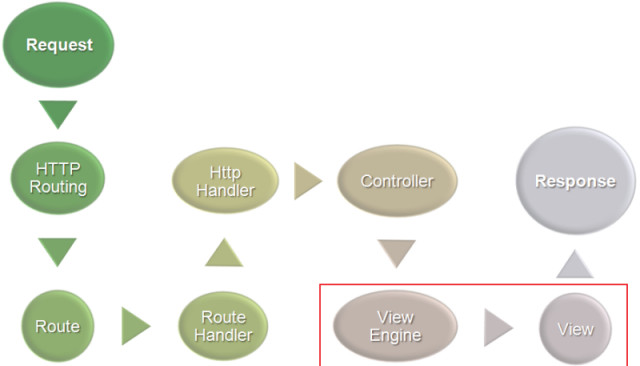
Asp.Net MVC Application Lifecycle
Routing
Asp.net Routing is the first step in MVC request cycle. Basically it is a pattern matching system that matches the request’s URL against the registered URL patterns in the Route Table. When a matching pattern found in the Route Table, the Routing engine forwards the request to the corresponding IRouteHandler for that request. The default one calls the MvcHandler. The routing engine returns a 404 HTTP status code against that request if the patterns is not found in the Route Table.When application starts at first time, it registers one or more patterns to the Route Table to tell the routing system what to do with any requests that match these patterns. An application has only one Route Table and this is setup in the Global.asax file of the application.
MvcHandler
The MvcHandler is responsible for initiating the real processing inside ASP.NET MVC. MVC handler implements IHttpHandler interface and further process the request by using ProcessRequest method.
Controller
As shown in above code, MvcHandler uses the IControllerFactory instance and tries to get a IController instance. If successful, the Execute method is called. The IControllerFactory could be the default controller factory or a custom factory initialized at the Application_Start event.
Action Execution
Once the controller has been instantiated, Controller's ActionInvoker determines which specific action to invoke on the controller. Action to be execute is chosen based on attributes ActionNameSelectorAttribute (by default method which have the same name as the action is chosen) and ActionMethodSelectorAttribute(If more than one method found, the correct one is chosen with the help of this attribute).
View Result
The action method receives user input, prepares the appropriate response data, and then executes the result by returning a result type. The result type can be ViewResult, RedirectToRouteResult, RedirectResult, ContentResult, JsonResult, FileResult, and EmptyResult.
View Engine
The first step in the execution of the View Result involves the selection of the appropriate View Engine to render the View Result. It is handled by IViewEngine interface of the view engine. By default Asp.Net MVC uses WebForm and Razor view engines. You can also register your own custom view engine to your Asp.Net MVC application .
View
Action method may returns a text string,a binary file or a Json formatted data. The most important Action Result is the ViewResult, which renders and returns an HTML page to the browser by using the current view engine.